Abstract
Deep-sea hydrothermal vent ecosystems host both symbiotic and non-symbiotic invertebrates. The non-symbiotic vent fauna is generally assumed to rely on free-living chemoautotrophic bacteria as their main food source but other sources such as detritus have recently been suggested to be a part of the invertebrate diets. Little is known about how food availability influences the distribution of vent organisms on a small scale. In addition, the feeding ecology and role of small, often numerically dominant invertebrates, the meiofauna is poorly understood at vents. In this study, we used stable carbon and nitrogen isotopic analysis to investigate the role of particulate detritus in the diets of macro- and meiobenthic invertebrates within three vent assemblages at Axial Volcano, Juan de Fuca Ridge, and Northeast Pacific. Particulate organic matter of a detrital origin became more important in the diet of invertebrates in assemblages typically associated with low-hydrothermal flow intensities. Meiobenthic species occupied several different feeding guilds and trophic levels in the assemblages investigated. We conclude that small-scale spatial variability in food sources is an important feature of vent food webs and that spatial patterns observed here and elsewhere are shaped by variations in hydrothermal discharge.




Similar content being viewed by others
References
Aarnio K, Bonsdorff E (1993) Seasonal variation in abundance and diet of the sand goby, Pomatoschistus minutus (Pallas), in a northern Baltic archipelago. Ophelia 37:19–30
Bergquist DC, Eckner JT, Urcuyo IA, Cordes EE, Hourdez S, Macko SA, Fisher CR (2007) Using stable isotopes and quantitative community characteristics to determine a local hydrothermal vent food web. Mar Ecol Prog Ser 330:49–65
Colaço A, Dehairs F, Desbruyères D (2002) Nutritional relations of deep-sea hydrothermal fields at the Mid-Atlantic Ridge: a stable isotope approach. Deep Sea Res I 49:395–412
Embley RW, Murphy KM, Fox CG (1990) High-resolution studies of the summit of Axial Volcano. J Geophys Res 95:12785–12812
Fisher CR (1990) Chemoautotrophic and methanotrophic symbiosis in marine invertebrates. Rev Aquat Sci 2:399–436
Fisher CR, Childress JJ, Macko SA, Brooks JM (1994) Nutritional interactions in Galapagos Rift hydrothermal vent communities: inferences from stable carbon and nitrogen isotope analyses. Mar Ecol Prog Ser 103:45–55
Gambi C, Vanreusel A, Danovaro R (2003) Biodiversity of nematode assemblages from deep-sea sediments of the Atacama Slope and Trench (South Pacific Ocean). Deep Sea Res I 50:103–117
Grelon D, Morineaux M, Desrosiers G, Juniper SK (2006) Feeding and territorial behavior of Paralvinella sulfincola a polychaete worm at deep-sea hydrothermal vents of the Northeast Pacific Ocean. J Exp Mar Biol Ecol 329:174–186
Guezennec J, Ortega-Morales O, Raguenes G, Geesey G (1998) Bacterial colonization of artificial substrate in the vicinity of deep-sea hydrothermal vents. FEMS Microbiol Ecol 26:89–99
Heptner MV, Ivanenko VN (2002) Copepoda (Crustacea) of hydrothermal ecosystems of the World Ocean. Arthropoda Selecta 11:117–134
Hicks GR, Coull BC (1983) The ecology of marine meiobenthic harpacticoid copepods. Oceanogr Mar Biol Rev 21:67–175
Jensen P (1991) 9 new and less known nematode species from the deep-sea benthos of the Norwegian Sea. Hydrobiologia 222:57–76
Karl DM (1995) Ecology of free-living, hydrothermal vent microbial communities. In: Karl DM (ed) Microbiology of extreme and unusual environments, vol 2. Deep-sea hydrothermal vent habitats. CRC, New York, pp 35–124
Kornicker L (1991) Myodocopid Ostracoda of hydrothermal vents in the eastern Pacific Ocean. Smithson Contrib Zool 516:1–46
Levesque C, Juniper SK (2002) Particulate matter as a food source at a nascent hydrothermal vent on the Juan de Fuca Ridge. Cah Biol Mar 43:289–292
Levesque C, Juniper SK, Marcus J (2003) Food resource partitioning and competition among alvinellid polychaetes of Juan de Fuca Ridge hydrothermal vents. Mar Ecol Prog Ser 246:173–182
Levesque C, Limén H, Juniper SK (2005) Origin, composition and nutritional quality of particulate matter at deep-sea hydrothermal vents on Axial Volcano, northeast Pacific. Mar Ecol Prog Ser 289:43–52
Levesque C, Juniper SK, Limén H (2006) Spatial organization of food webs along habitat gradients at deep-sea hydrothermal vents on Axial Volcano, Northeast Pacific. Deep Sea Res I 53:726–739
Limén H, Juniper SK (2006) Habitat controls on vent food webs at Eifuku Volcano, Mariana Arc. Cah Biol Mar 47:449–455
Limén H, Marty J (2004) Stable carbon and nitrogen isotope analysis on small-sized samples: a protocol for preparation and analysing microscopic organisms. Application Note, GV Instruments AN13
Limén H, Juniper SK, Tunnicliffe V, Clément M (2006) Benthic community structure on two peaks of an eruptive seamount: Northwest Rota−1 Volcano, Mariana Arc, western Pacific. Cah Biol Mar 47:457–463
Limén H, Stevens C J, Bourass Z, Juniper SK (2007) Copepods—a potential trophic link between hydrothermal vent bacteria and Paralvinellid polychaetes: lipid and stable isotope evidence. Mar Ecol Prog Ser (submitted)
Modig H, Ólafsson E (1998) Responses of Baltic benthic invertebrates to hypoxic events. J Exp Mar Biol Ecol 229:133–148
Moens T, Vincx M (1997) Observations on the feeding ecology of estuarine nematodes. J Mar Biol Assoc UK 77:211–227
Montagna PA (1984) In situ measurement of meiobenthic grazing rates on sediment bacteria and edaphic diatoms. Mar Ecol Prog Ser 18:119–130
Morineaux M, Grelon D, Juniper SK (2002) Utilization of nutritional resources and energy budgets for populations of the hydrothermal vent polychaete Paralvinella sulfincola on Axial Volcano, Juan de Fuca Ridge (Northeast Pacific). Cah Biol Mar 43:241–244
Ólafsson E (2003) Do macrofauna structure meiofauna assemblages in marine soft-bottoms? A review of experimental studies. Vie et Milieu 53:249–265
Ólafsson E, Modig H, van de Bund WJ (1999) Species specific uptake of radio-labelled phytodetritus by benthic meiofauna from the Baltic Sea. Mar Ecol Prog Ser 177:63–72
Phillips DL, Gregg JW (2001) Uncertainty in source partitioning using stable isotopes. Oecologia 127:171–179
Post DM (2002) Using stable isotopes to estimate trophic position: models, methods, and assumptions. Ecology 83:703–718
Robinson JJ, Cavanaugh CM (1995) Expression of form I and form II Ribulose-1,5-biphosphate carboxylase/oxygenase (Rubisco) in chemoautotrophic symbiosis: implications for the interpretation of stable isotope ratios. Limnol. Oceanogr. 40:1496–1502
Sarrazin J, Robigou V, Juniper SK, Delaney JR (1997) Biological and geological dynamics over four years on a high-temperature sulfide structure at the Juan de Fuca Ridge hydrothermal observatory. Mar Ecol Prog Ser 153:5–24
Sarrazin J, Juniper SK, Massoth G, Legendre P (1999) Physical and chemical factors influencing species distributions on hydrothermal sulfide edifices of the Juan de Fuca Ridge, northeast Pacific. Mar Ecol Prog Ser 190:89–112
Sarrazin J, Levesque C, Juniper SK, Tivey MK (2002) Mosaic community dynamics of Juan de Fuca Ridge sulfide edifices: Substratum, temperature and implications for trophic structure. Cah Biol Mar 43:275–279
Schmid-Araya JM, Hildrew AG, Robertson A, Schmid PE, Winterbottom J (2002) The importance of meiofauna in food webs: evidence from an acid stream. Ecology 83:1271–1285
Sievert SM, Ziebis W, Kuever J, Sahm K (2000) Relative abundance of Archaea and Bacteria along a thermal gradient of a shallow-water hydrothermal vent quantified by rRNA slot-blot hybridization. Microbiology 146:1287–1293
Smith LD, Coull BC (1987) Juvenile spot (Pisces) and grass shrimp predation on meiobenthos in muddy and sandy substrata. J Exp Mar Biol Ecol 105:123–136
Steyaert M, Garner N, van Gansbeke D, Vincx M (1999) Nematode communities from the North Sea: environmental controls on species diversity and vertical distribution within the sediment. J Mar Biol Assoc UK 79:253–264
Tsurumi M, de Graaf RC, Tunnicliffe V (2003) Distributional and biological aspects of copepods at hydrothermal vents on the Juan de Fuca Ridge, north-east Pacific ocean. J Mar Biol Assoc 83:469–477
Tunnicliffe V, Desbruyères D, Jollivet D, Laubier L (1993) Systematic and ecological characteristics of Paralvinella sulfincola Desbruyères and Laubier, a new polychaete (family Alvinellidae) from northeast Pacific Hydrothermal vents. Can J Zool 71:286–297
Van Dover CL, Fry B (1989) Stable isotopic compositions of hydrothermal vent organisms. Mar Biol 102:257–263
Van Dover CL, Fry B (1994) Microorganisms as food resources at deep-sea hydrothermal vents. Limnol Oceanogr 39:51–57
Vanaverbeke J, Arbizu PM, Dahms HU, Schminke HK (1997) The metazoan meiobenthos along a depth gradient in the Arctic Laptev Sea with special attention to nematode communities. Polar Biol 18:391–401
Vander Zanden MJ, Rasmussen JB (1999) Primary consumer δ13C and δ15N and the trophic position of aquatic consumers. Ecology 80:1395–1404
Vanhove S, Arntz W, Vincx M (1999) Comparative study of the nematode communities on the southeastern Weddell Sea shelf and slope (Antarctica). Mar Ecol Prog Ser 181:237–256
Vanhove S, Vermeeren H, Vanreusel A (2004) Meiofauna towards the South Sandwich Trench (750–6300 m), focus on nematodes. Deep Sea Res II 51:1665–1687
Vanreusel A, Van den Bossche I, Thiermann F (1997) Free-living marine nematodes from hydrothermal sediments: similarities with communities from diverse reduced habitats. Mar Ecol Prog Ser 157:207–218
Acknowledgments
We would like to thank the ROPOS crew and the Captain and crew of the R/V Thomas G. Thompson for assistance during sampling and C. Lalande and R. Léveillé for collecting samples. Thanks to M. Morineaux for help with sorting and preparing samples for stable isotope analysis and to A. Adamowicz, L. Cournoyer and J. McKay for performing the stable isotope analysis. Also, many thanks to J. Marty for valuable comments on the manuscript. This study was funded by an NSERC Canada Collaborative Research Opportunities grant to the CanRidge project and an NSERC Discovery grant to SKJ. This study was performed in Canada and is in compliance with current laws.
Author information
Authors and Affiliations
Corresponding author
Additional information
Communicated by R.J. Thompson.
Rights and permissions
About this article
Cite this article
Limén, H., Levesque, C. & Kim Juniper, S. POM in macro-/meiofaunal food webs associated with three flow regimes at deep-sea hydrothermal vents on Axial Volcano, Juan de Fuca Ridge. Mar Biol 153, 129–139 (2007). https://doi.org/10.1007/s00227-007-0790-1
Received:
Accepted:
Published:
Issue Date:
DOI: https://doi.org/10.1007/s00227-007-0790-1




